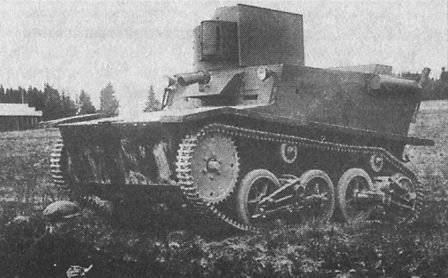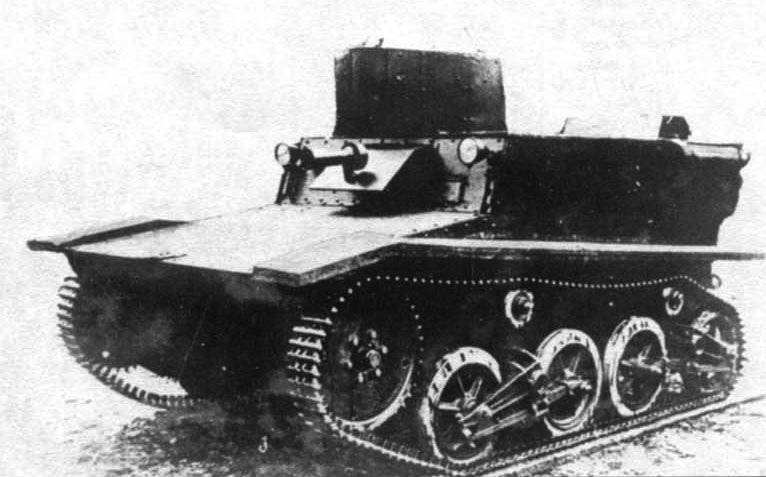Unusual tanks of Russia and the USSR. Amphibious tank T-41 1932 g
 The idea of creating an armored fighting vehicle, an amphibian capable of moving both on land and on water, attracted the attention of many tank engineers who were engaged in the design tanks and armored cars in the 20s and 30s of the last century. The tank builders of England and Germany tried to force the tank to conquer the water element, make it capable of crossing the water barrier and immediately enter the battle. Taking into account the features of the vast territory of the USSR, replete with rivers and lakes, which, in the absence of bridges and pontoon crossings, became an insurmountable obstacle for the tank, the government of the USSR and the top military leadership set the task of the speedy development of domestic amphibian tanks. As you know, there was practically no experience in creating this type of machine, they were all created by trial and error. One of the first experiments to create a floating tank in the USSR was the T-41 project.
The idea of creating an armored fighting vehicle, an amphibian capable of moving both on land and on water, attracted the attention of many tank engineers who were engaged in the design tanks and armored cars in the 20s and 30s of the last century. The tank builders of England and Germany tried to force the tank to conquer the water element, make it capable of crossing the water barrier and immediately enter the battle. Taking into account the features of the vast territory of the USSR, replete with rivers and lakes, which, in the absence of bridges and pontoon crossings, became an insurmountable obstacle for the tank, the government of the USSR and the top military leadership set the task of the speedy development of domestic amphibian tanks. As you know, there was practically no experience in creating this type of machine, they were all created by trial and error. One of the first experiments to create a floating tank in the USSR was the T-41 project. Work on this project began as early as March of 1932, using the English lightweight amphibious tank Vickers-Carden-Lloyd А4Е11 purchased in England in 1931, based on the unsuccessful experience of the first domestic project of the floating T-33 tank, began work. In a very short time, a group of engineers and designers under the leadership of N. Kozyrev developed the drawings and layout of the future car, booking and placing weapons. In July 1932, a prototype was created, which immediately went to the factory test. The amphibious hull was made of 5-9 mm non-armored steel sheets and assembled by riveting on the corners of high-strength steel, its tightness was ensured by the use of rubber gaskets at the joints. The layout of the tank was a slightly modified classic version, the rotating tower with a circular sector of attack was located on the hull, but was shifted to the left relative to the longitudinal axis of the machine. The rotation of the tower was carried out by the muscular effort of the turret arrow, for which shoulder and dorsal supports were provided.

The armament was limited to one 7,62 tank gun DT-29 installed in the ball joint. In the central part of the armored hull, an 4-cylinder, carburetor-type Ford-AA engine was installed, which developed power in the 42 hp. and allowing the car to move on hard ground at a speed of more than 35 km per hour. The undercarriage remained virtually unchanged, the same as on the English "Cardin-Loyd" wedge. A three-blade propeller was installed with the two steering surfaces located on the sides for movement in the water in the hull aft. For pumping outboard water, a water pump pump was provided, located in the stern of the machine next to the 120-liter fuel tank. In July, the 1931 of the year, a prototype machine was submitted to factory tests. The tests revealed that the engine power is not enough for the full use of the tank in combat, too much weight of the machine, 3, 2 tons, had an effect, movement in fourth gear was impossible. The results of the factory tests did not satisfy the selection committee, but after eliminating all the identified deficiencies, the amphibian, a month later, again in August returned to the testing ground where the machine was subjected to more thorough testing, but according to the results of the repeated tests the machine was again rejected. The high hull, weak bulletproof booking, which did not allow the amphibian to be under enemy fire for a long time, low maneuverability and the impossibility of maneuvering on the water, caused the refusal to adopt this vehicle.
Nevertheless, in the autumn of the same year, a modernized sample was presented for testing in which all errors found in the first version of the machine were taken into account. The amphibian mass was reduced to 2,9 tons, a new GAZ-AA engine was installed, the propeller was equipped with one steering plane and a reverse mechanism, which allowed the T-41 to move through the water not only forward, but also backwards, and the height of the vehicle was also reduced. The undercarriage underwent slight changes, one support roller was shot. The hope that better results will be shown in the new trials did not ultimately materialize. Assessing the capabilities of the new amphibian, the members of the test commission came to the conclusion that it was inexpedient to put it into service, but it was decided to release a small batch of vehicles during the 1932 year. It is known that the entire 12 lightweight T-41 amphibious tanks (serial) were released, most of them were in training units and there is no information about the combat use of these machines. However, this unsuccessful project certainly had an impact on the further development of domestic amphibious tanks, which took into account all the strengths and weaknesses of one of the first amphibious T-41 tanks.
Information